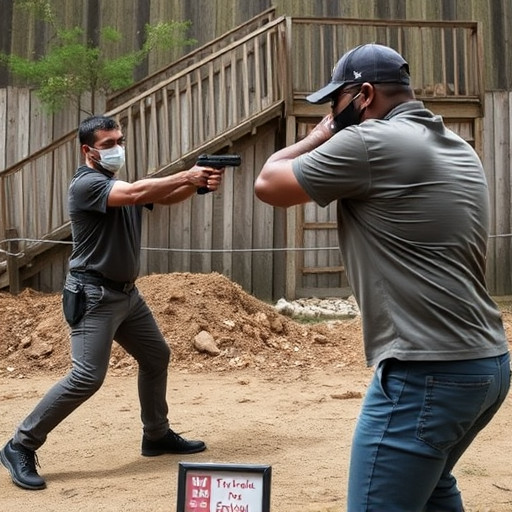Civilian Taser Ownership: State Laws, Pink Stun Guns, and Safety Features
Civilian ownership of tasers, particularly pink stun guns with disable pin safety features, is subje…….
Civilian ownership of tasers, particularly pink stun guns with disable pin safety features, is subject to intricate state-by-state legal frameworks. While some states allow limited possession for self-defense, others prohibit non-law enforcement use. These regulations cover age restrictions, permit requirements, training, power output, and storage rules. Understanding these laws is vital for compliance and personal safety, especially when considering the specific features of a pink stun gun with disable pin safety.
In an era where personal safety is paramount, understanding the legal landscape surrounding civilian taser ownership is crucial. This article dives into the complexities of state laws governing the possession of a pink stun gun equipped with a disable pin safety feature. We explore federal regulations against state-specific requirements, unravel eligibility criteria, and examine the role of safety features like disable pins. By shedding light on these aspects, we aim to empower individuals navigating the legal intricacies of civilian taser ownership.
- Understanding Civilian Taser Ownership: Legal Frameworks
- Federal Regulations vs. State Laws: Which Prevails?
- Eligibility Criteria for Owning a Pink Stun Gun
- Safety Features: The Role of Disable Pin Mechanisms
- State-Specific Requirements and Implications
Understanding Civilian Taser Ownership: Legal Frameworks

Understanding Civilian Taser Ownership: Legal Frameworks
In many jurisdictions, civilian taser ownership is regulated under strict legal frameworks designed to balance personal safety with public safety concerns. These laws vary widely from state to state, with some allowing limited taser possession for self-defense while others completely prohibit non-law enforcement use. One key consideration often involves the type of taser being purchased, such as a pink stun gun with disable pin safety feature, which can influence both accessibility and legal implications.
For instance, certain states may allow civilians to carry tasers if they undergo specific training and obtain a permit, while others might restrict them to law enforcement agencies only. Additionally, regulations on taser power output, use of force guidelines, and storage requirements further refine the legal landscape. Understanding these frameworks is crucial for anyone considering civilian taser ownership, ensuring compliance with local laws and maximizing personal safety measures.
Federal Regulations vs. State Laws: Which Prevails?

When it comes to civilian ownership of tasers, there’s a critical distinction between federal regulations and state laws. The Federal Government has set minimum standards for gun safety through the Comprehensive Safe Firearms Act (CFSA). However, states have the power to enact their own regulations, which can be more stringent than federal requirements. This means that while the CFSA establishes basic guidelines for responsible ownership, such as background checks and waiting periods, individual states can further regulate specific aspects like age restrictions, training mandates, and even the types of tasers allowed.
For example, some states may prohibit the possession of high-voltage tasers or those without disable pins (like a pink stun gun with a safety feature), while others might not have such restrictions. This patchwork of regulations can make navigating civilian taser ownership quite complex. Always check your state’s specific laws to ensure compliance and remember that state legislation often takes precedence over federal guidelines, creating a unique landscape for responsible taser ownership.
Eligibility Criteria for Owning a Pink Stun Gun

In many US states, civilians can legally own a pink stun gun, but there are stringent eligibility criteria that must be met. Typically, individuals looking to purchase one of these devices must be at least 18 years old and have no prior criminal record. Some states also require a permit or license to carry the stun gun in public, with specific rules regarding where and how it can be used.
One important feature to consider when buying a pink stun gun is the disable pin safety mechanism. This ensures that the device cannot be accidentally activated, providing an extra layer of control and safety for the user. States may have varying regulations on such features, so prospective buyers should check their local laws to ensure they comply with the requirements for responsible ownership.
Safety Features: The Role of Disable Pin Mechanisms

In the realm of civilian taser ownership, safety features play a crucial role in ensuring responsible use. One such vital component is the disable pin mechanism, which acts as a game changer in terms of user safety and control. These mechanisms are designed to prevent accidental discharges and unauthorized usage, making them an essential feature for any individual considering acquiring a pink stun gun with a disable pin safety feature.
The disable pin, often referred to as a safety switch or lock, requires the user to physically engage it before the taser can be activated. This simple yet effective step ensures that the device remains inactive until intended use, significantly reducing the risk of accidental shocks and ensuring the user has complete control over when and how the taser is deployed. Such safety features are particularly important for individuals who might carry their stun guns in high-stress situations, emphasizing the need for responsible ownership and handling.
State-Specific Requirements and Implications

Each state in the US has its own set of regulations regarding civilian ownership of tasers, creating a diverse landscape of requirements and restrictions. These laws can vary widely, from strict bans to relatively open access, shaping the rights and responsibilities of potential owners. One key aspect that differs across states is the specific type of taser allowed; some permit only certain models, focusing on safety features like disable pins or limited energy output. For instance, many states have embraced modern designs, allowing pink stun guns with built-in safety mechanisms, ensuring responsible ownership while providing individuals with a unique self-defense option.
Implications of these state-specific requirements are significant for citizens seeking self-defense tools. Owners must thoroughly understand the laws in their respective states to avoid legal repercussions and ensure they purchase and possess the correct equipment. This scrutiny often encourages responsible purchasing decisions, as owners want to stay within legal boundaries while arming themselves with effective protection. Additionally, these regulations can drive innovation in taser design, pushing manufacturers to incorporate safety features that cater to both consumer needs and legal standards.
In conclusion, navigating civilian taser ownership requires understanding a complex interplay of federal regulations and state laws. When considering purchasing a pink stun gun equipped with a disable pin safety feature, it’s crucial to familiarize yourself with your state’s specific requirements. Each jurisdiction has unique eligibility criteria and safety guidelines, ensuring responsible use. By adhering to these legal frameworks, individuals can exercise their right to self-defense while prioritizing public safety.


